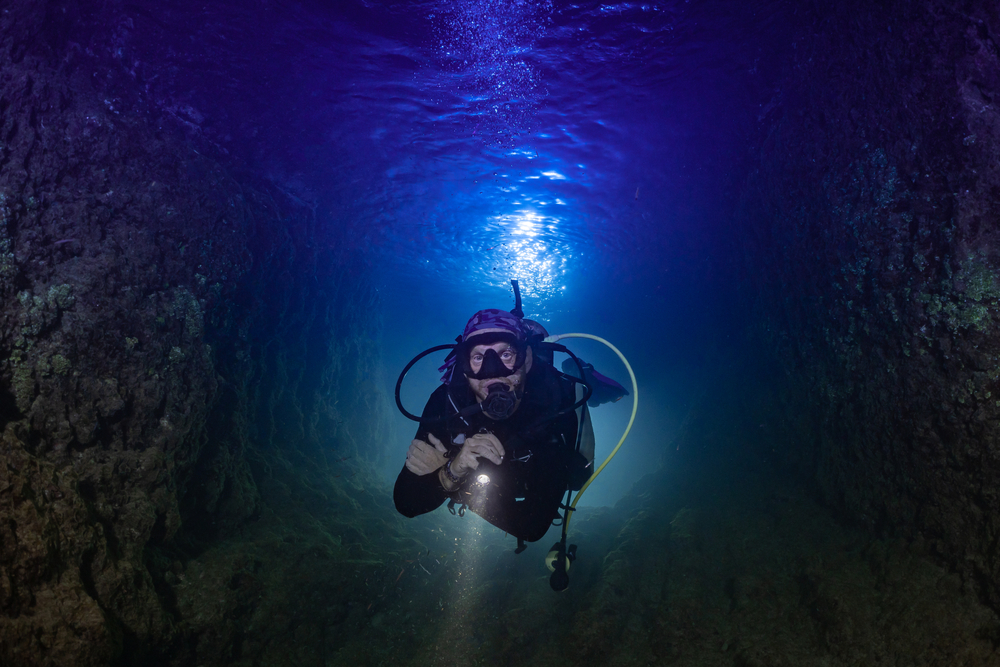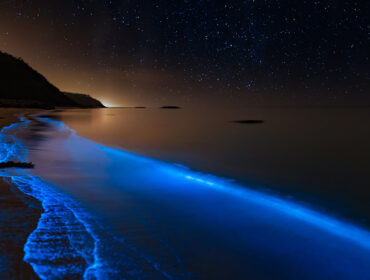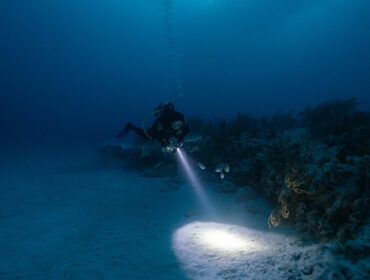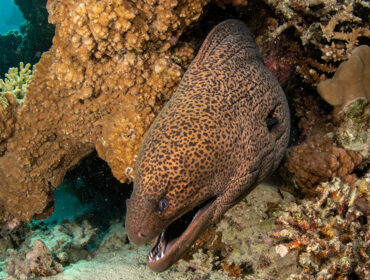Night scuba diving is an entirely different experience from daytime diving. As the sun sets and darkness takes over, the underwater world transforms into a mysterious and mesmerizing environment. The ocean’s usual daytime residents retreat, making way for nocturnal marine life, glowing plankton, and eerie, otherworldly landscapes. The stillness, combined with the glow of your dive light, creates a thrilling and peaceful adventure.
But night scuba diving isn’t just about diving in the dark; it requires proper preparation, awareness, and equipment. Whether you’re planning a manta ray night dive in Kona, a bioluminescent dive in the Maldives, or just exploring a reef after sunset, knowing what to expect is essential. This guide will cover what makes night diving special, what to expect, the necessary gear, and the best locations worldwide.
What to Expect on Your First Night Scuba Diving Experience
- Limited Visibility: Your dive light becomes your vision, focusing on small details instead of vast landscapes.
- More Active Marine Life: Nocturnal creatures like octopuses, eels, and lobsters emerge, making night dives uniquely exciting.
- Different Communication: Use dive light signals, as hand gestures are more challenging to see in low visibility.
- Heightened Senses – Movement, sounds, and light appear more dramatic, making each dive more immersive.
- A Peaceful Experience: The ocean feels quieter, with only your breathing and light guiding you through the darkness.

Essential Gear for Night Scuba Diving
Because diving at night introduces new challenges, having the right gear is crucial for safety and enjoyment.
1. Primary Dive Light
Your main dive light is your most essential piece of equipment. It should be bright enough to illuminate marine life without scaring them off. Look for a wide-beam LED light that offers at least 1000 lumens of brightness.
Blue Reef 3000 Lumens Zoomable Dive Light
This powerful torch cuts through the darkness, ensuring you see clearly underwater. You can switch between a focused spotlight and a wide floodlight with an adjustable beam. Waterproofing ensures it works at extreme depths without fail. It offers three lighting modes, allowing you to adjust brightness as needed. The long beam distance helps divers see far ahead. With a strong rechargeable battery, you get hours of uninterrupted use. The convenient USB Type-C charging makes recharging quick and hassle-free.
2. Tank Marker Light or Glow Stick
A small LED light or glow stick attached to your tank helps your dive buddy and the dive guide keep track of you in the dark. Most divers use different colors to distinguish themselves easily.
Bigblue Easy Clip Marker Light with Flash
This small safety light clips easily onto mask straps or gear for effortless attachment. Its compact design won’t get in the way while diving. Despite its low-light output, it provides enough illumination to mark your presence. Its long battery life means you can rely on it for multiple dives without frequent changes. Using coin-cell batteries keeps maintenance simple and affordable. Different color options help divers identify each other underwater.
3. Compass for Navigation
Even if you’re following a guide, it’s wise to carry a compass to help with navigation. Underwater landmarks familiar during the day can look entirely different at night.
Apeks Bungee Mount Compass
This compass is designed for quick reading, even in challenging conditions. Its oil-filled casing ensures smooth movement and accurate readings. The bungee mount allows for a secure, flexible fit on your wrist. Its tilt compensation keeps readings steady, even when your arm moves. The durable build ensures it withstands pressure and repeated use.
4. Wrist-Mounted Dive Computer
A good dive computer helps you monitor depth, air supply, and dive time without a flashlight. Some models even have glow-in-the-dark screens for better visibility in low-light conditions.
Suunto EON Core Wrist Computer
The large color display on this wrist computer makes information clear and easy to read. Despite its size, the case remains lightweight and comfortable on the wrist. It supports multiple dive modes, making it suitable for all experience levels. With advanced algorithms, it provides accurate dive calculations for safer descents and ascents. Bluetooth compatibility allows seamless data syncing with your devices. Whether diving with air, nitrox, or trimix, it adapts to your needs.
5. Exposure Suit
Water temperatures feel colder at night, even in tropical locations. A wetsuit or drysuit will help keep your body temperature stable and prevent post-dive chills.
NeoSport 3mm Waterman Unisex 2-Piece Wetsuit Package
This suit is built to handle demanding conditions without compromise. The two-piece design allows for better insulation and versatility. Flatlock seams provide added comfort and reduce irritation. Premium neoprene offers excellent warmth and flexibility. A heavy-duty zipper ensures easy entry and exit without struggles.
Safety Tips for Night Scuba Diving
- Dive with a Buddy: Stay close, use dive lights for communication, and never dive alone in low visibility.
- Use Proper Lighting: Carry a primary and backup dive light. Use a tank marker light for visibility.
- Plan and Mark Exit Points: Know the site, mark entry/exit points with glow sticks or surface markers.
- Move Slowly: Sudden movements can disorient you and startle marine life. Stay calm and controlled.
- Monitor Air and Time: Check your dive computer and air supply frequently to avoid exceeding limits.
- Be Aware of Marine Life: Nocturnal creatures behave differently. Avoid shining lights directly into their eyes.
- Maintain Buoyancy: Prevent stirring up sediment or damaging coral by controlling your buoyancy.
- Stay Close to Entry Point: Keep track of your navigation markers or compass to avoid drifting.
- Check Equipment: Test all gear, especially lights and regulators, before entering the water.
- Use Light Signals: Hand signals are more challenging to see; use light flashes or circles to communicate.
Final Thoughts
If you’re a diver looking to see the ocean in a new way, night scuba diving is an experience you won’t forget. The peace, mystery, and nocturnal marine life make it a thrilling and calming adventure. Whether swimming with manta rays in Kona, exploring glowing plankton in the Maldives, or watching the reefs come to life after dark, every night dive is unique.
So, grab your dive light, take a deep breath, and get ready to explore the ocean after dark!
Frequently Asked Questions
Some dive shops require an Advanced Open Water certification, but others allow night dives for beginners with an experienced guide.
Not at all! If you stay with your buddy, use the right gear, and follow safety guidelines, night diving is as safe as daytime diving.
First, practice daytime diving at the same site, get comfortable using a dive light, and move slowly to avoid disorientation.
Expect to see octopuses, lobsters, crabs, eels, and sometimes even sharks hunting in the darkness.
Bonaire and Cozumel are great beginner-friendly spots, while the manta ray night dive in Kona is an excellent guided first-time experience.





